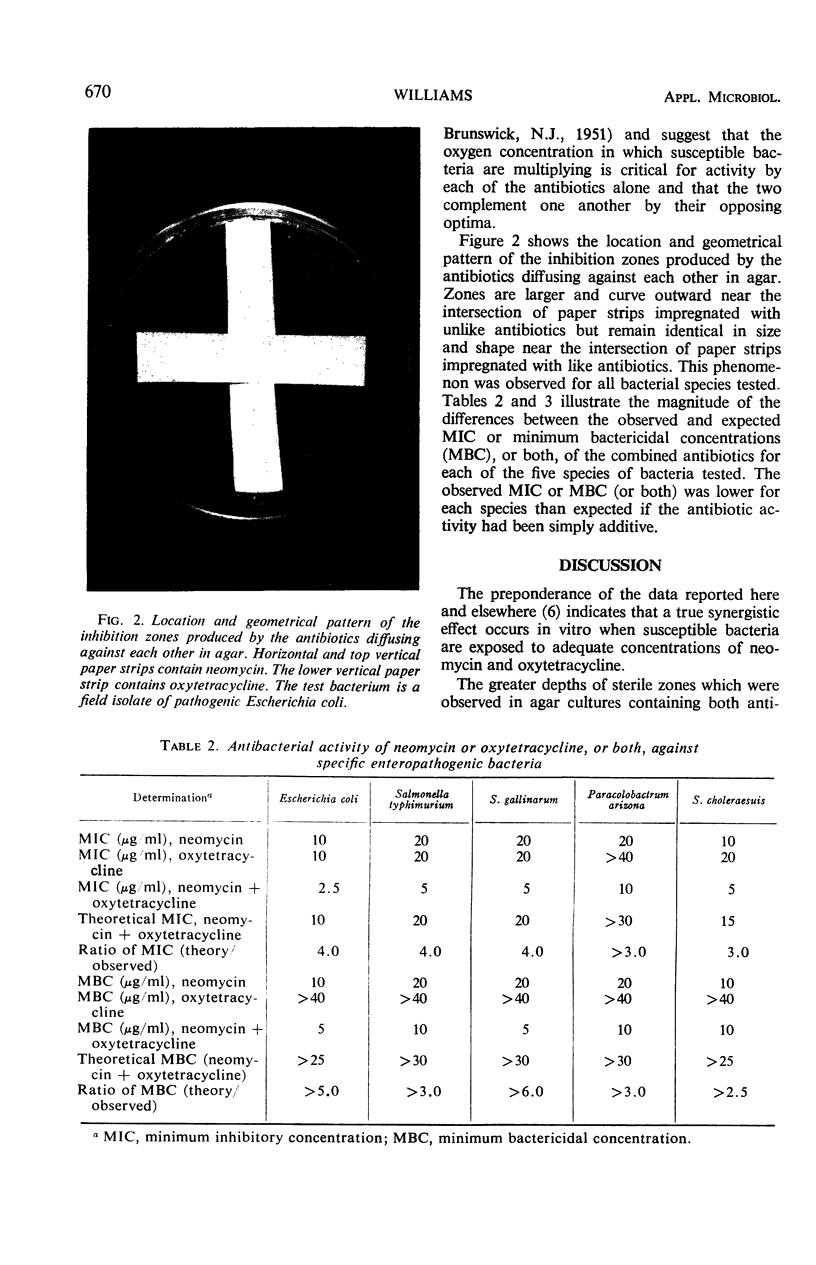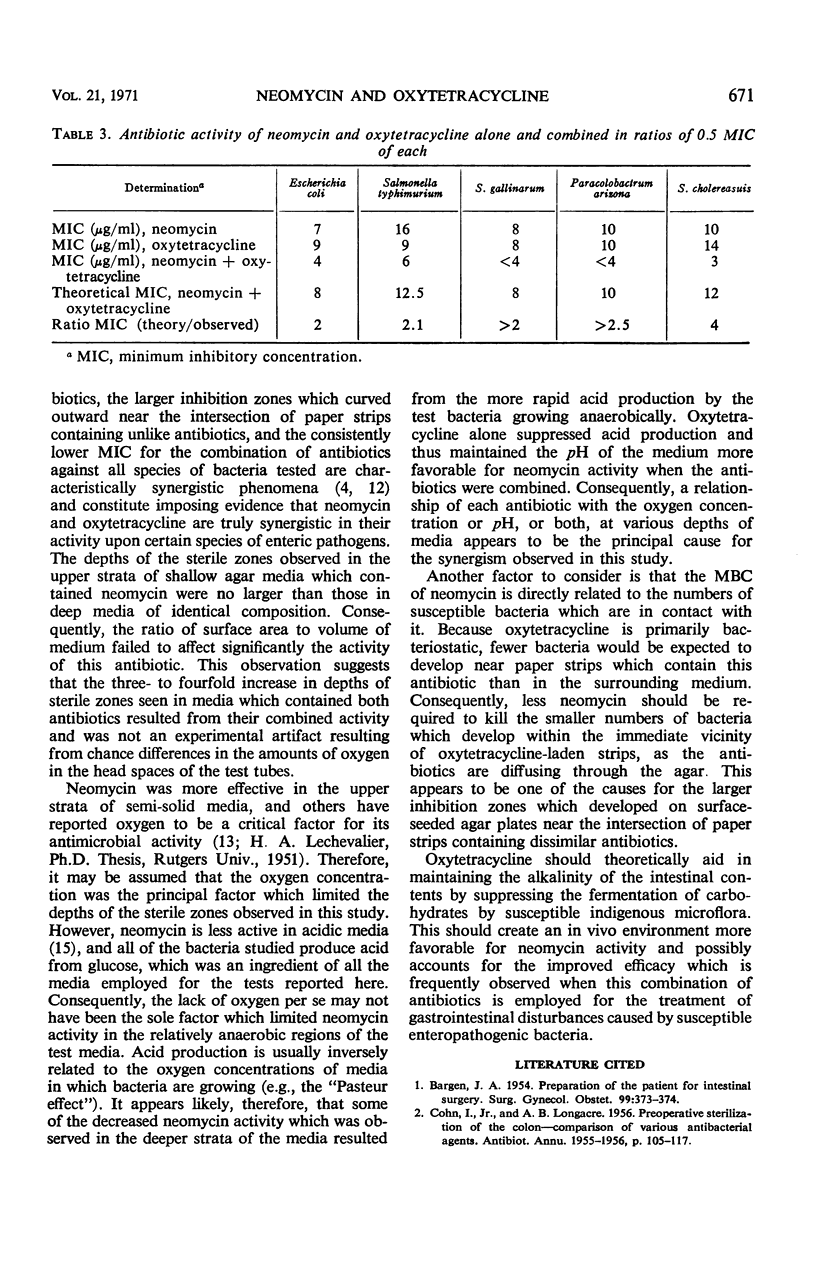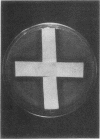Abstract
Six strains of enteropathogenic gram-negative bacteria were tested for susceptibility to neomycin or oxytetracycline alone and combined in fixed ratios. The minimal inhibitory concentration for the combination was less than one-half of that expected if the antibiotic activities were simply additive. Neomycin alone was more effective against bacteria multiplying in the presence of abundant oxygen, whereas oxytetracycline alone was more effective against bacteria multiplying in relatively anaerobic environments; when combined, the antibiotics complemented each other by their opposing optima for activity. Oxygen concentration, pH, and neomycin activity are related, and the depression of acid production by oxytetracycline is believed to be partially responsible for the synergistic activity of this pair of antibiotics.
Full text
PDF




Images in this article
Selected References
These references are in PubMed. This may not be the complete list of references from this article.
- BARGEN J. A. Preparation of the patient for intestinal surgery. Surg Gynecol Obstet. 1954 Sep;99(3):373–374. [PubMed] [Google Scholar]
- COHN I., Jr, LONGACRE A. B. Preoperative sterilization of the colon; comparison of various antibacterial agents. Antibiot Annu. 1955;3:105–117. [PubMed] [Google Scholar]
- Dowling H. F. An overview of the use of combinations of antibiotics. Antimicrob Agents Chemother (Bethesda) 1967;7:234–235. [PubMed] [Google Scholar]
- GARROD L. P., WATERWORTH P. M. Methods of testing combined antibiotic bactericidal action and the significance of the results. J Clin Pathol. 1962 Jul;15:328–338. doi: 10.1136/jcp.15.4.328. [DOI] [PMC free article] [PubMed] [Google Scholar]
- JAWETZ E., GUNNISON J. B., COLEMAN V. R., KEMPE H. C. A laboratory test for bacterial sensitivity to combinations of antibiotics. Am J Clin Pathol. 1955 Sep;25(9):1016–1031. doi: 10.1093/ajcp/25.9.1016. [DOI] [PubMed] [Google Scholar]
- JEWETZ E., GUNNISON J. B., BRUFF J. B., COLEMAN V. R. Studies on antibiotic synergism and antagonism. Synergism among seven antibiotics against various bacteria in vitro. J Bacteriol. 1952 Jul;64(1):29–39. doi: 10.1128/jb.64.1.29-39.1952. [DOI] [PMC free article] [PubMed] [Google Scholar]
- Jawetz E. Combined antibiotic action: some definitions and correlations between laboratory and clinical results. Antimicrob Agents Chemother (Bethesda) 1967;7:203–209. doi: 10.1128/AAC.7.2.203. [DOI] [PubMed] [Google Scholar]
- Krcmery V., Kellen J. Changes in some enzymes of bacterial electron transport accompanying development of resistance to oxytetracycline. J Bacteriol. 1966 Oct;92(4):1264–1266. doi: 10.1128/jb.92.4.1264-1266.1966. [DOI] [PMC free article] [PubMed] [Google Scholar]
- Krcméry V., Kellen J. The mechanism of the action of tetracycline antibiotics. 9. Inhibition of cytochrome oxidase by oxytetracycline. J Hyg Epidemiol Microbiol Immunol. 1966;10(3):339–345. [PubMed] [Google Scholar]
- Mathies A. W., Jr, Leedom J. M., Ivler D., Wehrle P. F., Portnoy B. Antibiotic antagonism in bacterial meningitis. Antimicrob Agents Chemother (Bethesda) 1967;7:218–224. [PubMed] [Google Scholar]
- Sabath L. D. Synergy of antibacterial substances by apparently known mechanisms. Antimicrob Agents Chemother (Bethesda) 1967;7:210–217. [PubMed] [Google Scholar]
- Waksman S. A., Lechevalier H. A., Harris D. A. NEOMYCIN-PRODUCTION AND ANTIBIOTIC PROPERTIES. J Clin Invest. 1949 Sep;28(5 Pt 1):934–939. doi: 10.1172/JCI102182. [DOI] [PMC free article] [PubMed] [Google Scholar]




